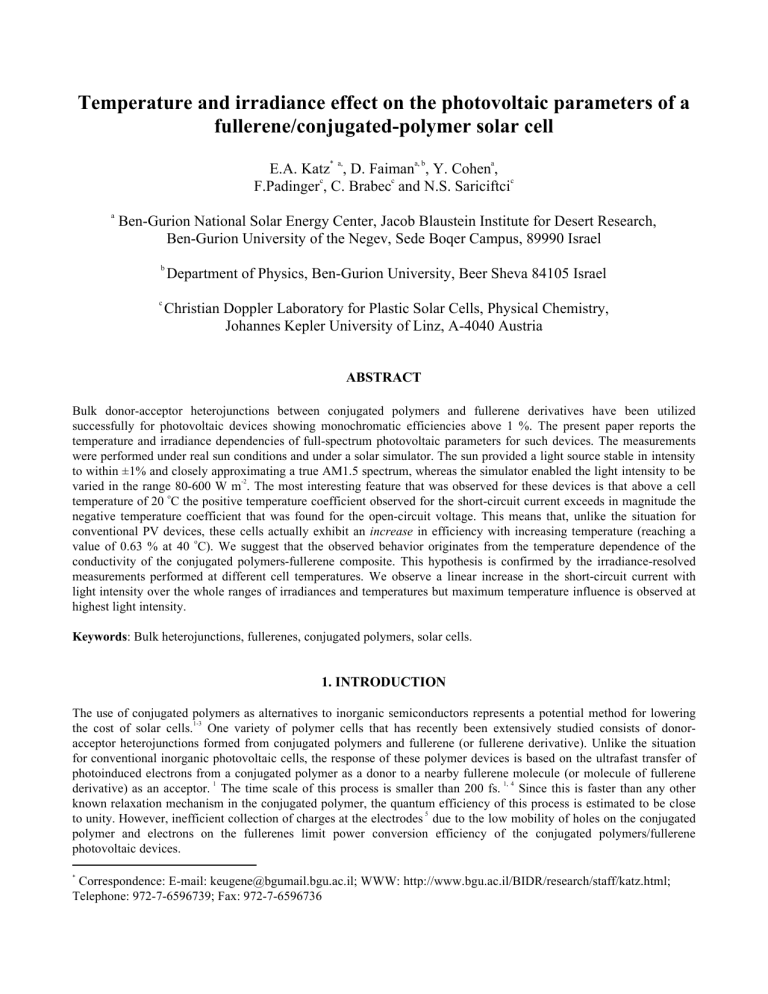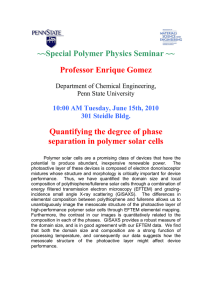Temperature and irradiance effect on the photovoltaic

Temperature and irradiance effect on the photovoltaic parameters of a fullerene/conjugated-polymer solar cell
E.A. Katz
* a,
, D. Faiman
a, b
, Y. Cohen
a
,
F.Padinger
c
, C. Brabec
c
and N.S. Sariciftci
c a
Ben-Gurion National Solar Energy Center, Jacob Blaustein Institute for Desert Research,
Ben-Gurion University of the Negev, Sede Boqer Campus, 89990 Israel
b
Department of Physics, Ben-Gurion University, Beer Sheva 84105 Israel
c
Christian Doppler Laboratory for Plastic Solar Cells, Physical Chemistry,
Johannes Kepler University of Linz, A-4040 Austria
ABSTRACT
Bulk donor-acceptor heterojunctions between conjugated polymers and fullerene derivatives have been utilized successfully for photovoltaic devices showing monochromatic efficiencies above 1 %. The present paper reports the temperature and irradiance dependencies of full-spectrum photovoltaic parameters for such devices. The measurements were performed under real sun conditions and under a solar simulator. The sun provided a light source stable in intensity to within ±1% and closely approximating a true AM1.5 spectrum, whereas the simulator enabled the light intensity to be varied in the range 80-600 W m
-2
. The most interesting feature that was observed for these devices is that above a cell temperature of 20 o
C the positive temperature coefficient observed for the short-circuit current exceeds in magnitude the negative temperature coefficient that was found for the open-circuit voltage. This means that, unlike the situation for conventional PV devices, these cells actually exhibit an increase in efficiency with increasing temperature (reaching a value of 0.63 % at 40 o
C). We suggest that the observed behavior originates from the temperature dependence of the conductivity of the conjugated polymers-fullerene composite. This hypothesis is confirmed by the irradiance-resolved measurements performed at different cell temperatures. We observe a linear increase in the short-circuit current with light intensity over the whole ranges of irradiances and temperatures but maximum temperature influence is observed at highest light intensity.
Keywords: Bulk heterojunctions, fullerenes, conjugated polymers, solar cells.
1. INTRODUCTION
The use of conjugated polymers as alternatives to inorganic semiconductors represents a potential method for lowering the cost of solar cells.
1-3 One variety of polymer cells that has recently been extensively studied consists of donoracceptor heterojunctions formed from conjugated polymers and fullerene (or fullerene derivative). Unlike the situation for conventional inorganic photovoltaic cells, the response of these polymer devices is based on the ultrafast transfer of photoinduced electrons from a conjugated polymer as a donor to a nearby fullerene molecule (or molecule of fullerene derivative) as an acceptor.
1 The time scale of this process is smaller than 200 fs.
1, 4 Since this is faster than any other known relaxation mechanism in the conjugated polymer, the quantum efficiency of this process is estimated to be close to unity. However, inefficient collection of charges at the electrodes 5 due to the low mobility of holes on the conjugated polymer and electrons on the fullerenes limit power conversion efficiency of the conjugated polymers/fullerene photovoltaic devices.
*
Correspondence: E-mail: keugene@bgumail.bgu.ac.il; WWW: http://www.bgu.ac.il/BIDR/research/staff/katz.html;
Telephone: 972-7-6596739; Fax: 972-7-6596736
The best photovoltaic parameters, an in particular, monochromatic energy conversion efficiencies above 1 %, were reported for bulk donor-acceptor heterojunctions between conjugated polymers and fullerene derivatives.
6 - 7
The present paper reports the temperature and irradiance dependencies of photovoltaic parameters for such devices measured under real sun conditions and under a solar simulator.
2. EXPERIMENT
The bulk donor-acceptor heterojunction solar cells were produced by a spin casting process at the Christian Doppler
Laboratory for Plastic Solar Cells. The production process is described in details elsewhere.
7-8 Poly [2-methoxy, 5-(3’,7’dimethyl-octyloxy)]-p-phenylene-vinelyne (MDMO-PPV) was used as the electron donor 9 while the electron acceptor was [6,6]-Phenyl C61 - butyric acid methyl ester (PCBM).
10 The enhanced solubility of PCBM compared to C
60
allows a high fullerene/conjugated polymers ratio and strongly supports the formation of bulk donor-acceptor heterojunctions. The thickness of the spincast film was about 100 nm. As electrodes a transparent ITO film on a plastic substrate on one side and an Al layer on the other side were used. The device structure of such plastic solar cells is shown in Fig. 1.
plastic substrate
To I-V tracer
ITO layer
MDMO-PPV/PCBM mixture
Al layer
Fig. 1: Schematic device structure of the fullerene/conjugated polymer solar cells under study.
Prior to photovoltaic investigation, the cells were sandwiched between two glass microscope slides, sealed by epoxy and express-mailed to the Ben-Gurion National Solar Energy Center at Sede Boqer. There, the photovoltaic properties of these “plastic” solar cells were studied, indoors, under irradiation by a filtered metal halide solar simulator (Solar
Constant 575) and, outdoors, under real sunlight. The samples were illuminated on the ITO/substrate side.
The simulator was adjusted to a number of light intensity levels in the range 80 - 600 Wm -2 and the corresponding current-voltage characteristics of the cells were recorded. Fig.2 shows the short-circuit current (Isc) of a typical cell, as a function of the simulator light intensity level, at various cell temperatures. One can observe a linear increase in Isc with light intensity over the whole ranges of irradiances and temperatures. Therfore, to compare different outdoor measurements of current and efficiency (see below) we may adjust the obtained data to the standard irradiance of 1000
W m -2 .
Outdoors, current-voltage measurements were performed on cloudless days, during the noon-time period, at normal incidence to the incoming solar beam radiation. The solar irradiance, measured with a thermopile pyranometer (Eppley
PSP), was found to remain constant, during the test runs, to within approximately ± 0.3 % at levels that slightly exceeded
1000 W
⋅ m -2 .
11 Moreover, under such conditions the measured sunlight spectrum at Sede Boqer is found 12 to be exceedingly close to the standard AM1.5 spectrum.
The cell temperature, during both simulator and natural sunlight tests, was controlled by a thermoelectric cooling plate upon which the cell was mounted. Measurements were performed at cell temperatures up to 40 o C.
0.30
0.25
0.20
0.15
0.10
Isc (33 degC) [mA]
Isc (25 degC) [mA]
Isc (20 degC)
Isc (10 degC) [mA]
0.05
0.00
0 100 200 300 400
Irradiance [W/sq.m]
500 600
Fig. 2: Short-circuit current (Isc) vs. Irradiance level, at various cell temperatures.
3. RESULTS AND DISCUSSION
Four successive outdoor measurements of I-V curves of the plastic solar cells, each of area 2.4 cm
2
, were performed at various cell temperatures in the approximate range -10 - +40 o
C. The duration of each measurement (i.e. total exposure of the cell to sunlight) was about 200 sec. Between measurements the cells were kept in the dark, in a refrigerator. The temperature dependence of the principal cell parameters - short-circuit current (Isc), open-circuit voltage (Voc) and energy conversion efficiency (
η
) are plotted in Fig. 3 - 5 for a typical solar cell. The results obtained on successive days, when compared to one another, reveal a strikingly large rate of performance degradation for these devices. This is attributed to degradation of photogeneration and transport properties of conjugated polymer - fullerene composite material. Recently faster degradation rate was found for the polymer compared with the fullerene in this material.
13
These cells will accordingly require further work on material stabilization and encapsulation.
To start with, we will concentrate on the results of the first measurements (14.06.99). The I-V curves obtained from these measurements are shown in Fig.6 for two cell temperatures, 25 and 35 o
C. The values of Voc observed at these temperatures were 0.830 V and 0.813 V, respectively. This is more than two times higher that the work function difference of the two electrodes (Al - 4.3 eV, ITO - 4.7 eV), which would give a value of 0.4 V. It is also considerably higher than the Voc value of 0.53 V observed for bilayer conjugated polymer/fullerene solar cells under intense illumination.
14
This result strongly supports the conclusion formulated in Ref. 7 that photovoltage generation in bulk
860
840
820
800
780
760
740
-10
Voc (14.6.99)
Voc (15.6.99)
Voc (21.6.99)
Voc (24.6.99)
0 10 20 30
Cell Temperature [degC]
40 50
Fig. 3: Open-circuit voltage (Voc) vs. cell temperature, during outdoor tests, 14-24 June 1999.
0.70
0.65
0.60
0.55
0.50
0.45
0.40
-10
Isc (14.6.99)
Isc (15.6.99)
Isc (21.6.99)
Isc (24.6.99)
Isc = 0.49 + 2.28e-3 x T
0 10 20 30
Cell Temperature [degC]
40 50
Fig. 4: Isc (adjusted to irradiance 1000 W m
-2
) vs. cell temperature during outdoor tests 14-24 June 1999.
0.7
0.6
Eta (14.6.99)
Eta (15.6.99)
Eta (21.6.99)
Eta (24.6.99)
0.5
0.4
0.3
-10 0 10 20 30 40 50
Cell Temperature [degC]
Fig. 5: Efficiency
η
(adjusted to irradiance 1000 Wm -2 ) vs. cell temperature, during outdoor tests 14-24 June 1999.
0.6
0.5
0.4
0.3
0.2
I-V (25 degC)
I-V (35 degC)
T = 25 degC:
Isc = 0.550 mA, Voc = 830 mV,
FF = 32.4 %, Efficency = 0.62 %
T = 35 degC:
Isc = 0.599 mA, Voc = 813 mV,
FF = 30.0 %, Efficiency = 0.61 %
0.1
0.0
0 200 400 600
Voltage [mV]
800 1000
Fig. 6: I-V curves at T = 25 o C and T = 35 o C for the first outdoor tests (June 14,1999).
donor-acceptor heterojunctions can not be explained exclusively by a model of the work function difference of the two electrodes
15
(which is generally accepted for single layer conjugated polymers devices
16 - 17
), or by a picture involving only band bending at the ‘polymer/fullerene’ interface (which is adequate for bilayer conjugated polymer/fullerene solar cells with non rectifying metal contacts
14
). Further investigation of the photovoltage generation mechanism for bulk donoracceptor heterojunctions is thus required.
The low value of FF, approximately 0.3, is typical for organic solar cells
1 - 3
and in our case may be attributed to the low conductivity of both the conjugated polymer and fullerene channels in the composite material of the cells. On the other hand, the observed value of
η
, above 0.6%, is relatively high for organic solar cells measured under the full AM1.5
Spectrum.
Fig. 3 shows Voc as a function of cell temperature for the four outdoor experimental runs that were performed during the
14 - 24/6/99 period. All measurements of Voc show the familiar linear decrease with increasing temperature, with slope in the range of 1.40 - 1.65 mV K
-1
.
However, unlike conventional inorganic solar cells, a relatively large monotonic increase in Isc with temperature is also in evidence, for all measurements. Specifically, a linear increase with slope in the range 2.1 - 2.9 mA K
-1
is observed over the whole temperature range (Fig.4).
One may further observe that the increase of current with temperature actually overtakes the decrease of voltage with temperature at some temperature To above 20 o C (depending on the state of degradation). Thereafter,
η
actually rises with temperature, increasing up to 40 o C. A positive temperature dependence of
η is accordingly one of the most unusual features of these solar cells (Fig. 5).
It is important to note that elevated temperatures (~ 40 o C) may be achieved merely by the absorption of solar radiation, i.e., without any additional heating.
The efficiency turn-over temperature, To,was observed to change as the cell degraded, thus the absolute value that was observed by us is probably not significant. Nevertheless, a similar positive temperature coefficient for efficiency was previously observed in some fullerene-based solar cells of another kind - C60 Single Crystal Photoelectrochemical Cells,
18 so it is probably a real effect rather than an artifact caused by cell degradation. This conclusion is strongly supported by the very recent measurements of new conjugated polymers/fullerene bulk heterojunction solar cells.
19 Preliminary measurements under irradiation by a solar simulator revealed
η
value of 1.6 - 2.1 % for the cells of area 0.075 cm 2 and temperature dependencies of the main cell parameters (Voc, Isc and
η
) qualitatively reproducing thouse reported in this paper (Fig. 3 - 5). Furthermore, the slope of the Voc decrease was found to be 1.45 mV K
-1
, which fits exactly in the range of our findings.
We believe that the observed behavior of Isc and
η
originates from the temperature dependence of the conductivity of the fullerene/conjugated polymer composite which, as was mentioned above, is the main limiting factor for charge collection in this kind of solar cells. This hypothesis is in accord with our irradiance-resolved measurements performed at different cell temperatures using the solar simulator (Fig.2). In those measurements we observe a linear increase in Isc with light intensity over the whole above mentioned range of irradiance and temperature, but the slope of the irradiancedependence of Isc increases with increasing temperature. In the other words, the maximum temperature influence is observed at the highest light intensities. At such intensities a maximum amount of photocarriers are generated and the limiting, caused by low mobility of holes in the conjugated polymer and electrons in the fullerene channels, is strongest.
4. CONCLUSIONS
The paper reports the temperature and irradiance dependencies of full-spectrum photovoltaic parameters for fullerene/conjugated polymer bulk heterojunctions solar cells. An unusual feature - possibly of significant importance - is the relatively large dIsc/dT for this kind of device, leading to a rise in efficiency with temperature. We suggest that the
observed behavior originates from the temperature dependence of the conductivity of the conjugated polymers-fullerene composite. This hypothesis is confirmed by the irradiance-resolved measurements performed at different cell temperatures. We observe a linear increase in Isc with light intensity over the whole ranges of irradiances and temperatures but maximum temperature influence is observed at highest light intensity.
ACKNOWLEDGMENT
This work was funded in part by the European Community DG XII under contract No. JOR3-CT-98-0206 (DG 12 -
WSMN). E.A.K. also thanks financial support by the Israel Ministry of Emigrant Absorption and Gensseler Foundation.
REFERENCES
1. N.S. Sariciftci and A.J. Heeger, “Photophysics, Charge Separation and Device Application of Conjugated
Polymer/Fullerene Composites”, Handbook of Organic Conductive Molecules and Polymers, v.1, ed. by H.S. Nalwa pp. 413 - 455, John Willey & Sons Ltd, New York, 1997.
2. N. S. Sariciftci, L. Smilowitz, A. J. Heeger, and F. Wudl, “Photoinduced electron transfer from a conducting polymer to Buckminsterfullerene”, Science 258 pp. 1474 - 1476, 1992.
3. J.J. M. Halls, C.A. Walsh, N.C. Greenham, E.A. Marseglia, R.H. Friend, S.C. Moratti, and A.B. Holmes, “Efficient photodiodes from interpenetrating polymer networks”, Nature (London) 376, pp. 498 - 500, 1995.
4. L. Smilowitz, N. S. Sariciftci, R. Wu, C. Gettinger, A.J. Heeger and F. Wudl, “Photoexcitation spectroscopy of conducting polymer - C
60
composites: Photoinduced electron transfer”, Phys. Rev. B 47, pp. 13835 - 13842, 1993.
5.
J. Gao, F. Hide, and H. Wang, “Efficient photodetectors and photovoltaic cells from composites of fullerenes and conjugated polymers: Photoinduced electron transfer”, Synth. Met. 84, pp. 979 - 980, 1997.
6.
G. Yu, J. Gao, J.C. Hummelen, F. Wudl and A.J. Heeger, “Polymer Photovoltaic cells: enhanced efficiencies via a network of internal donor-acceptor heterojunctions”, Science 270, pp.1789 -1791, 1995.
7.
C.J. Brabec, F. Padinger, N.S. Sariciftci and J.C. Hummelen, “Photovoltaic properties of conjugated polymer/fullerene composites embedded in a polystyrene matrix”J. Appl. Phys. 85, pp. 6866 - 6872, 1999.
8.
C.J. Brabec, F. Padinger, V. Dyakonov, J.C. Hummelen R.A.J. Janssen and N.S. Sariciftci, “Realization of large area flexible fullerene - conjugated polymer photocells: a route to plastic solar cells”, Electronic Properties of Novel
Materials: Molecular Nanostructures, ed. by H. Kuzmany, J. Fink, M. Mehring and S. Roth, AIP Confrences
Proceedings, 442, pp. 519 - 522, Woodbury, New York, 1998.
9. G.H. Gelinck, J. Warman, E.G.J. Staring, “Polaron pair formation, migration, and decay on photoexcited poly(phenylenevinylene) chains”, J.Phys. Chem. 100, pp. 5485 - 5491, 1996.
10.
J.C. Hummelen, B.W. Knight, F. Lepec, F. Wudl, “Preparation and characterization of fulleroid and methanofullerene derivatives”, J. Org. Chem. 60, pp. 532 - 538, 1995.
11.
D. Berman, S. Biryukov and D. Faiman, “EVA laminate browning after five years in a grid-connected, mirrorassisted, photovoltaic system in the Negev desert - Effect on module efficiency”, Sol. Energy Mater. Sol. Cells 36, pp. 421 - 432, 1995.
12.
D. Berman and D. Faiman, “EVA browning and the time-dependence of I-V curve parameters on PV modules with and without mirror-enhancement in a desert environment”, Sol. Energy Mater. Sol. Cells 45, p. 401 - 412, 1997.
13.
H. Neugebauer, C. Brabec, J.C. Hummelen and N.S. Sariciftci, “Stability and photodegradation mechanisms of conjugated polymer / fullerene plastic solar cells”, Sol. Energy Mater. Sol. Cells 61, pp. 35 - 42, 2000.
14.
L. N. S. Sariciftci, D. Braun, C. Zhang, V.I. Srdanov, A.J. Heeger, G. Stucky and F. Wudl, “Semiconducting polymer - Buckminsterfullerene heterojunctions: Diodes, photodiodes and photovoltaic cells”, Appl. Phys. Lett. 62, pp. 585 - 587, 1993.
15.
I.D. Parker, “Carrier tunneling and device characteristics in polymer light-emitting diodes”, J. Appl. Phys. 75, pp.
1656 - 1666, 1994.
16.
G. Yu and A.J. Heeger, “Charge separation and photovoltaic conversion in polymer composites with internal donoracceptor heterojunctions”, J. Appl. Phys. 78, pp. 4510 - 4515, 1995.
17.
G. Yu, C. Zhang and A.J. Heeger, “Dual-function semiconducting polymer devices: Light-emitting and photodetecting diodes”, Appl. Phys. Lett. 64, pp. 1540 - 1542, 1994.
18.
S. Licht, P.A. Ramakrishnan, D. Faiman, E.A. Katz, A. Shames and S. Goren, “Temperature and O
2
depletion effects in fullerene photoelectrochemical solar cells” Sol. Energy Mater. Sol. Cells 56, pp. 45 - 56, 1998.
19.
J.M. Kroon, private communication.

